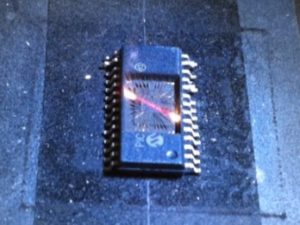Crack Microcontroller ATmega2560V Heximal
Crack Microcontroller ATmega2560V memory and help engineer to recover Heximal from MCU flash and eeprom, the heximal can be rewrite to other blank Microprocessor ATmega2560V for IC cloning;

Crack Microcontroller ATmega2560V memory and help engineer to recover Heximal from MCU flash and eeprom, the heximal can be rewrite to other blank Microprocessor ATmega2560V for IC cloning
The Code memory array can be programmed using the serial SPI bus while RST is pulled to VCC. The serial interface consists of pins SCK, MOSI (input) and MISO (output) when crack mcu PIC12F675 bin.
After RST is set high, the Programming Enable instruction needs to be executed first before program/erase operations can be executed. An auto-erase cycle is built into the self-timed programming operation (in the serial mode ONLY) and there is no need to first execute the Chip Erase instruction unless any of the lock bits have been programmed if mcu pic16f630 firmware breakin.
The Chip Erase operation turns the content of every memory location in the Code array into FFH. The Code memory array has an address space of 0000H to 2FFFH before MCU PIC16F676 code extraction.
Either an external system clock is supplied at pin XTAL1 or a crystal needs to be connected across pins XTAL1 and XTAL2. The maximum serial clock (SCK) frequency should be less than 1/40 of the crystal frequency.
With a 24 MHz oscillator clock, the maximum SCK frequency is 600 kHz. To program and verify the AT89S53 in the serial programming mode, the following sequence is recommended:
- Power-up sequence: Apply power between VCC and GND pins. Set RST pin to “H”. If a crystal is not connected across pins XTAL1 and XTAL2, apply a 3 MHz to 24 MHz clock to XTAL1 pin and wait for at least 10 milliseconds if microcontroller PIC16F639 hex cracking.
- Enable serial programming by sending the Programming Enable serial instruction to pin MOSI/P1.5. The frequency of the shift clock supplied at pin SCK/P1.7 needs to be less than the CPU clock at XTAL1 divided by 40.
- The Code array is programmed one byte at a time by supplying the address and data together with the appropriate Write instruction. The selected memory location is first automatically erased before new data is written.
- The write cycle is self-timed and typically takes less than 2.5 ms at 5V. Any memory location can be verified by using the Read instruction which returns the content at the selected address at serial output MISO/P1.6 before microcontroller PIC16F737 flash unlocking.
- At the end of a programming session, RST can be set low to commence normal operation. Power-off sequence (if needed): Set XTAL1 to “L” (if a crystal is not used). Set RST to “L”. Turn VCC power off.
Tags: unlock microprcessor archive,unlock microprcessor binary,unlock microprcessor code,unlock microprcessor content,unlock microprcessor data,unlock microprcessor eeprom,unlock microprcessor file,unlock microprcessor firmware,unlock microprcessor heximal,unlock microprcessor information,unlock microprcessor memory,unlock microprcessor program

